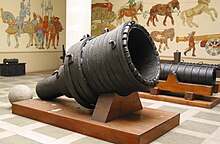Barring Gun


The bar ring gun is a medieval design of a gun .
Smaller guns were cast from bronze or forged from a piece of iron as early as the 14th century . However, with the forging and casting processes of that time, it was initially not possible to manufacture larger one-piece iron guns that could withstand the high stresses caused by large powder charges. Therefore, the barrels of large guns were made up of several parts, each made up of individual components that were relatively easy to manufacture. The guns consist of rectangular or trapezoidal iron rods that are placed around a wooden model to form a barrel. Then the glowing iron rings were shrunk on, which fixed the iron rods against each other when they cooled down. So that the log did not start to burn, it was coated with damp clay or charred all around. At the mouth, the iron bars were often forged into a ring and reinforced with an additional coated ring. Finally, the barrel of the gun was forged and smoothed inside. In the 15th century both cast (e.g. Faule Mette ) and forged bar ring guns were manufactured, later the cast guns completely replaced the bar ring guns.
Well-known barring guns are: Lazy Maid , Mons Meg , Dulle Griet and Pumhart von Steyr .
For modern gun barrels reinforced with rings, see ring cannon .
literature
- Volker Schmidtchen: bombards, fortifications, gunsmiths . Droste, Düsseldorf 1977, ISBN 3-7700-0471-X , p. 18-27 .
- Friedrich Dörge: The history of the wire gun barrel . In: History of technology: Contributions to the history of technology and industry . No. 27 , 1938, pp. 30-40 .
Individual evidence
- ↑ Technology History , Volumes 44-45, 1977, page 158
